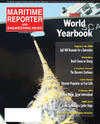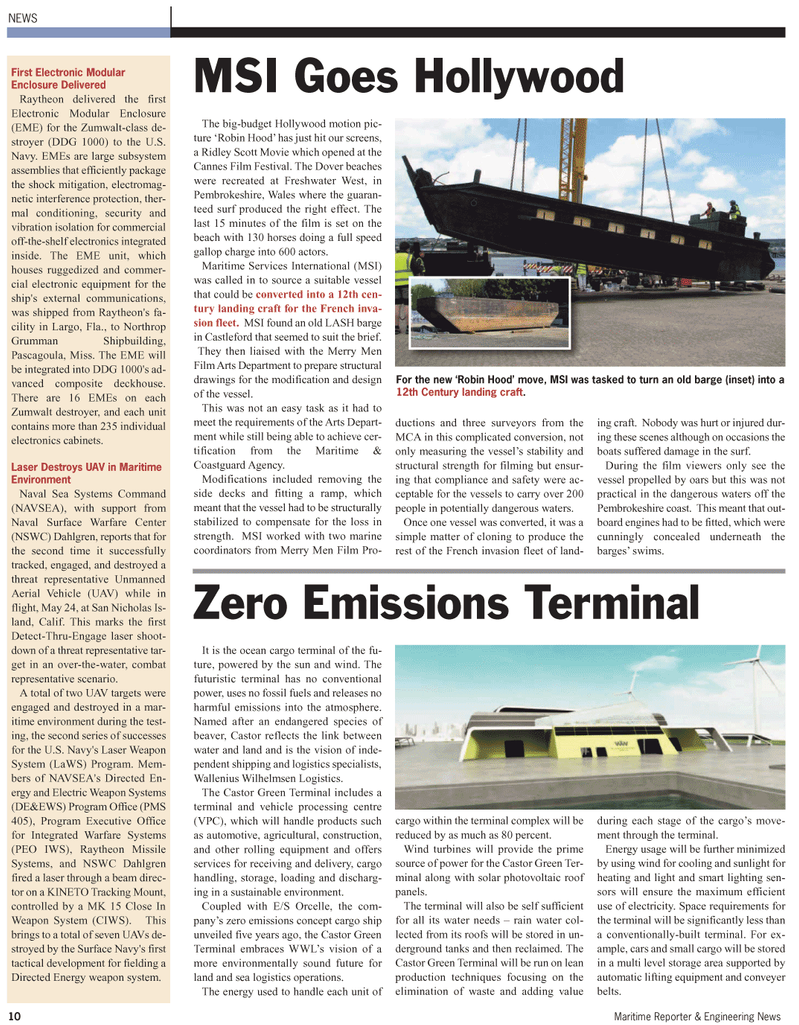
Page 10: of Maritime Reporter Magazine (June 2, 2010)
Read this page in Pdf, Flash or Html5 edition of June 2, 2010 Maritime Reporter Magazine
10 Maritime Reporter & Engineering News
NEWS
First Electronic Modular
Enclosure Delivered
Raytheon delivered the first
Electronic Modular Enclosure (EME) for the Zumwalt-class de- stroyer (DDG 1000) to the U.S.
Navy. EMEs are large subsystem assemblies that efficiently package the shock mitigation, electromag- netic interference protection, ther- mal conditioning, security and vibration isolation for commercial off-the-shelf electronics integrated inside. The EME unit, which houses ruggedized and commer- cial electronic equipment for the ship's external communications, was shipped from Raytheon's fa- cility in Largo, Fla., to Northrop
Grumman Shipbuilding,
Pascagoula, Miss. The EME will be integrated into DDG 1000's ad- vanced composite deckhouse.
There are 16 EMEs on each
Zumwalt destroyer, and each unit contains more than 235 individual electronics cabinets.
Laser Destroys UAV in Maritime
Environment
Naval Sea Systems Command (NAVSEA), with support from
Naval Surface Warfare Center (NSWC) Dahlgren, reports that for the second time it successfully tracked, engaged, and destroyed a threat representative Unmanned
Aerial Vehicle (UAV) while in flight, May 24, at San Nicholas Is- land, Calif. This marks the first
Detect-Thru-Engage laser shoot- down of a threat representative tar- get in an over-the-water, combat representative scenario.
A total of two UAV targets were engaged and destroyed in a mar- itime environment during the test- ing, the second series of successes for the U.S. Navy's Laser Weapon
System (LaWS) Program. Mem- bers of NAVSEA's Directed En- ergy and Electric Weapon Systems (DE&EWS) Program Office (PMS 405), Program Executive Office for Integrated Warfare Systems (PEO IWS), Raytheon Missile
Systems, and NSWC Dahlgren fired a laser through a beam direc- tor on a KINETO Tracking Mount, controlled by a MK 15 Close In
Weapon System (CIWS). This brings to a total of seven UAVs de- stroyed by the Surface Navy's first tactical development for fielding a
Directed Energy weapon system.
The big-budget Hollywood motion pic- ture ‘Robin Hood’ has just hit our screens, a Ridley Scott Movie which opened at the
Cannes Film Festival. The Dover beaches were recreated at Freshwater West, in
Pembrokeshire, Wales where the guaran- teed surf produced the right effect. The last 15 minutes of the film is set on the beach with 130 horses doing a full speed gallop charge into 600 actors.
Maritime Services International (MSI) was called in to source a suitable vessel that could be converted into a 12th cen- tury landing craft for the French inva- sion fleet. MSI found an old LASH barge in Castleford that seemed to suit the brief.
They then liaised with the Merry Men
Film Arts Department to prepare structural drawings for the modification and design of the vessel.
This was not an easy task as it had to meet the requirements of the Arts Depart- ment while still being able to achieve cer- tification from the Maritime &
Coastguard Agency.
Modifications included removing the side decks and fitting a ramp, which meant that the vessel had to be structurally stabilized to compensate for the loss in strength. MSI worked with two marine coordinators from Merry Men Film Pro- ductions and three surveyors from the
MCA in this complicated conversion, not only measuring the vessel’s stability and structural strength for filming but ensur- ing that compliance and safety were ac- ceptable for the vessels to carry over 200 people in potentially dangerous waters.
Once one vessel was converted, it was a simple matter of cloning to produce the rest of the French invasion fleet of land- ing craft. Nobody was hurt or injured dur- ing these scenes although on occasions the boats suffered damage in the surf.
During the film viewers only see the vessel propelled by oars but this was not practical in the dangerous waters off the
Pembrokeshire coast. This meant that out- board engines had to be fitted, which were cunningly concealed underneath the barges’ swims.
MSI Goes Hollywood
For the new ‘Robin Hood’ move, MSI was tasked to turn an old barge (inset) into a 12th Century landing craft.
It is the ocean cargo terminal of the fu- ture, powered by the sun and wind. The futuristic terminal has no conventional power, uses no fossil fuels and releases no harmful emissions into the atmosphere.
Named after an endangered species of beaver, Castor reflects the link between water and land and is the vision of inde- pendent shipping and logistics specialists,
Wallenius Wilhelmsen Logistics.
The Castor Green Terminal includes a terminal and vehicle processing centre (VPC), which will handle products such as automotive, agricultural, construction, and other rolling equipment and offers services for receiving and delivery, cargo handling, storage, loading and discharg- ing in a sustainable environment.
Coupled with E/S Orcelle, the com- pany’s zero emissions concept cargo ship unveiled five years ago, the Castor Green
Terminal embraces WWL’s vision of a more environmentally sound future for land and sea logistics operations.
The energy used to handle each unit of cargo within the terminal complex will be reduced by as much as 80 percent.
Wind turbines will provide the prime source of power for the Castor Green Ter- minal along with solar photovoltaic roof panels.
The terminal will also be self sufficient for all its water needs – rain water col- lected from its roofs will be stored in un- derground tanks and then reclaimed. The
Castor Green Terminal will be run on lean production techniques focusing on the elimination of waste and adding value during each stage of the cargo’s move- ment through the terminal.
Energy usage will be further minimized by using wind for cooling and sunlight for heating and light and smart lighting sen- sors will ensure the maximum efficient use of electricity. Space requirements for the terminal will be significantly less than a conventionally-built terminal. For ex- ample, cars and small cargo will be stored in a multi level storage area supported by automatic lifting equipment and conveyer belts.
Zero Emissions Terminal

 9
9

 11
11
